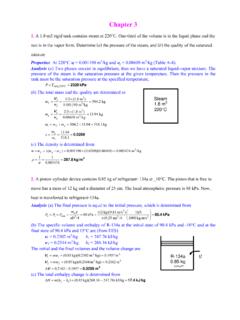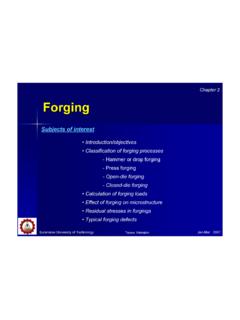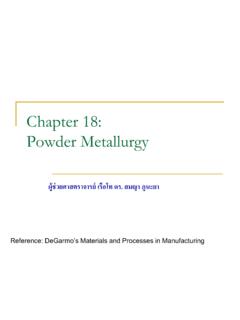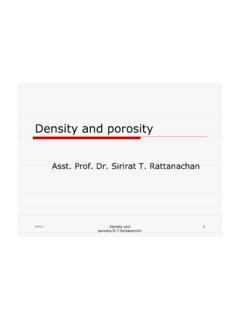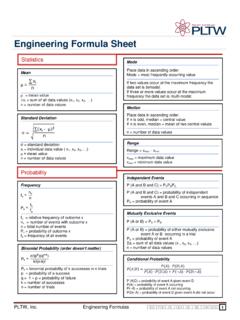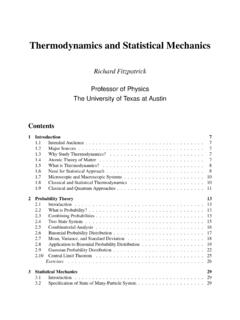Transcription of Chapter 9 solution
1 Chapter 9 9 14 An air-standard cycle with variable specific heats is executed in a closed system and is composed of the following four processes: 1-2 Isentropic compression from 100 kPa and 27 C to 800 kPa 2-3 v = constant heat addition to 1800 K 3-4 Isentropic expansion to 100 kPa 4-1 P =constant heat rejection to initial state (a) Show the cycle on P-v and T-s diagrams. (b) Calculate the net work output per unit mass. (c) Determine the thermal efficiency. 9-14 The four processes of an air-standard cycle are described.
2 The cycle is to be shown on P-v and T-s diagrams, and the net work output and the thermal efficiency are to be determined. Assumptions 1 The air-standard assumptions are applicable. 2 Kinetic and potential energy changes are negligible. 3 Air is an ideal gas with variable specific heats. Properties The properties of air are given in Table A-17. Analysis (b) The properties of air at various states are ()()()kJ/kg 2668kPa 100kPa 2668kPa 800K 18001310kJ/kg 1800K 100kPa ====== === === ===== =hPPPPPTTPTPTPPuTTuPPPPPhTrrrrrrvv From energy balances, ,14out23in= = == = == = =qqwhhquuq (c) Then the thermal efficiency becomes ,thqw v P1 2 4 3 qin qout sT1 2 4 3 qin qout 9 22 Consider a Carnot cycle executed in a closed system with kg of air.
3 The temperature limits of the cycle are 300 and 900 K, and the minimum and maximum pressures that occur during the cycle are 20 and 2000 kPa. Assuming constant specific heats, determine the net work output per cycle. 9-22 A Carnot cycle with the specified temperature limits is considered. The net work output per cycle is to be determined. Assumptions Air is an ideal gas with constant specific heats. Properties The properties of air at room temperature are cp = , cv = kJ/kg K, R = , and k = (Table A-2).
4 Analysis The minimum pressure in the cycle is P3 and the maximum pressure is P1. Then, or, ()()()kPa 300K 900kPa = = = kkkkTTPPPPTT The heat input is determined from Then, ()()( )()()()( )kJ = == = = = = = kJ 900K 30011kJ 900kg 2000kPa ,th12in1201212 QWTTssmTQPPRTTcssHLHp sT32qin qout 4 1 900300 9 34 An ideal Otto cycle has a compression ratio of 8. At the beginning of the compression process, air is at 95 kPa and 27 C, and 750 kJ/kg of heat is transferred to air during the constant-volume heat-addition process.
5 Taking into account the variation of specific heats with temperature, determine (a) the pressure and temperature at the end of the heataddition process, (b) the net work output, (c) the thermal efficiency, and (d) the mean effective pressure for the cycle. Answers: (a) 3898 kPa, 1539 K, (b) kJ/kg, (c) percent, (d ) 495 kPa 9-34 An ideal Otto cycle with air as the working fluid has a compression ratio of 8. The pressure and temperature at the end of the heat addition process, the net work output, the thermal efficiency, and the mean effective pressure for the cycle are to be determined.
6 Assumptions 1 The air-standard assumptions are applicable. 2 Kinetic and potential energy changes are negligible. 3 Air is an ideal gas with variable specific heats. Properties The gas constant of air is R = The properties of air are given in Table A-17. Analysis (a) Process 1-2: isentropic compression. =ruTv ()()()kPa 1705kPa 95K 300K == === ====PTTPTPTPuTrrrrvvvvvvvvv Process 2-3: v = constant heat addition. kJ/kg ,2323in23,== =+=+= =rTquuuuqvK1539 ()kPa3898 kPa 1705K 15392233222333= == =PTTPTPTPvv (b) Process 3-4: isentropic expansion.
7 ()( )kJ/kg ====uTrrrrvvvvv Process 4-1: v = constant heat rejection. kJ / kg= = =41 kJ/kg = = ,qqw v P413 2 750 kJ/kg (c) 750kJ/kg ,thqw (d) ()()()() kJmkPa1/81/kgm )/11( ,21outnet,max2minmax33111= = = ===== ==rwwrPRTvvvvvvvv 9 47 An air-standard Diesel cycle has a compression ratio of 16 and a cutoff ratio of 2. At the beginning of the compression process, air is at 95 kPa and 27 C. Accounting for the variation of specific heats with temperature, determine (a) the temperature after the heat-addition process, (b) the thermal efficiency, and (c) the mean effective pressure.
8 Answers: (a) K, (b) percent, (c) kPa 9-47 An air-standard Diesel cycle with a compression ratio of 16 and a cutoff ratio of 2 is considered. The temperature after the heat addition process, the thermal efficiency, and the mean effective pressure are to be determined. Assumptions 1 The air-standard assumptions are applicable. 2 Kinetic and potential energy changes are negligible. 3 Air is an ideal gas with variable specific heats. Properties The gas constant of air is R = The properties of air are given in Table A-17.
9 Analysis (a) Process 1-2: isentropic compression. =ruTv ()kJ/kg ====hTrrrrvvvvv Process 2-3: P = constant heat addition. ()() ==== =rhTTTTPTP vvvvv K (b) = =hhq Process 3-4: isentropic expansion. () =====urrrrrvvvvvvvv Process 4-1: v = constant heat rejection. v P412 3 qin qout = == = =kJ/kg (c) ()()()()() kJmkPa1/161/kgm 95K 300K/kgmkPa ,21outnet,max2minmax33111outinoutnet,= = = ===== === = =rwwrPRTqqwvvvvvvvv 9 84 A gas-turbine power plant operates on the simple Brayton cycle between the pressure limits of 100 and 1200 kPa.
10 The working fluid is air, which enters the compressor at 30 C at a rate of 150 m3/min and leaves the turbine at 500 C. Using variable specific heats for air and assuming a compressor isentropic efficiency of 82 percent and a turbine isentropic efficiency of 88 percent, determine (a) the net power output, (b) the back work ratio, and (c) the thermal efficiency. Answers: (a) 659 kW, (b) , (c) 9-84 A gas-turbine plant operates on the simple Brayton cycle. The net power output, the back work ratio, and the thermal efficiency are to be determined.

